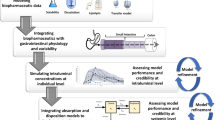Abstract
Bitopertin (RG1678) is a glycine reuptake inhibitor in phase 3 trials for treatment of schizophrenia. Its clinical oral pharmacokinetics is sensitive to changes in drug substance particle size and dosage form. Physiologically based pharmacokinetic (PBPK) absorption model simulations of the impact of changes in particle size and dosage form (either capsules, tablets, or an aqueous suspension) on oral pharmacokinetics was verified by comparison to measured plasma concentrations. Then, a model parameter sensitivity analysis was applied to set limits on the particle sizes included in tablets for the market. The model was also used to explore the in vitro to in vivo correlation. Simulated changes in oral pharmacokinetics caused by differences in particle size and dosage form were confirmed in two separate relative bioavailability studies. Model parameter sensitivity analyses predicted that AUCinf was hardly reduced as long as particle diameter (D50) remained smaller than 30 μm, and >20% reduced Cmax is anticipated only when particle diameter exceeds 15 μm. An exploration of the sensitivity to the presence of larger particles within a polydisperse distribution showed that simulated Cmax is again more affected than AUC but is less than 20% reduced as long as D50 is less than 8 μm and D90 is smaller than 56 μm. PBPK absorption modelling can contribute to a quality by design (QbD) approach for clinical formulation development and support the setting of biorelevant specifications for release of the product.







Similar content being viewed by others
References
Agoram B, Woltosz WS, et al. Predicting the impact of physiological and biochemical processes on oral drug bioavailability. Adv Drug Deliv Rev. 2001;50(Supplement 1):S41–67.
Alberati D, Moreau J-L, et al. Glycine reuptake inhibitor RG1678: a pharmacologic characterization of an investigational agent for the treatment of schizophrenia. Neuropharmacology. 2012;62(2):1152–61.
Cheeti S, Budha NR, et al. A physiologically based pharmacokinetic (PBPK) approach to evaluate pharmacokinetics in patients with cancer. Biopharm Drug Dispos. 2013;34:141–54.
Department of Heath and Human Services, U. S. F. a. D. A. 2007 Pharmaceutical Quality for the 21st Century A Risk-Based Approach Progress Report. http://www.fda.gov/aboutfda/centersoffices/officeofmedicalproductsandtobacco/cder/ucm128080.htm. Accessed 12 Jan 2014
Galia E, Nicolaides E, et al. Evaluation of various dissolution media for predicting in vivo performance of class I and class II drugs. Pharm Res. 1998;15:698–705.
Hyman SE. A glimmer of light for neuropsychiatric disorders. Nature. 2008;455(7215):890–3.
Javitt DC. Glycine transport inhibitors for the treatment of schizophrenia: symptom and disease modification. Current Opin Drug Discov Dev. 2009;12(4):468.
Javitt DC. Glutamate and Schizophrenia: phencyclidine, N-Methyl-d-Aspartate receptors, and dopamine–glutamate interactions. Int Rev Neurobiol. 2007;78:69–108. Academic Press.
Jiang W, Kim S, et al. The role of predictive biopharmaceutical modeling and simulation in drug development and regulatory evaluation. Int J Pharm. 2011;418(2):151–60.
Juran JM. Juran on quality by design: the new steps for planning quality into goods and services: planning, setting and reaching quality goals the free press. A division of Simon and Schuster Inc; 1992.
Kuentz M. Drug absorption modeling as a tool to define the strategy in clinical formulation development. AAPS J. 2008;10(3).
Kuentz M, Nick S, et al. A strategy for preclinical formulation development using GastroPlusTM as pharmacokinetic simulation tool and a statistical screening design applied to a dog study. Eur J Pharm Sci. 2006;27:91–9.
Lu ATK, Frisella ME, et al. Dissolution modeling: factors affecting the dissolution rates of polydisperse powders. Pharm Res. 1993;10(9).
Malvern. Mastersizer 2000. http://www.malvern.com/en/products/product-range/mastersizer-range/mastersizer-2000/default.aspx. Accessed 27 Feb 2014
Mathias NR, Crison J. The use of modeling tools to drive efficient oral product design. Aaps Journal. 2012;14(3):591–600.
Noyes AS, Whitney WR. The rate of solution of solid substances in their own solutions. J Am Chem Soc. 1897;19:930–4.
Parrott N, Hainzl D, et al. Physiologically based pharmacokinetic modelling to predict single and multiple dose human pharmacokinetics of bitopertin. Clin Pharmacokinet. 2013;52(8):673–83.
Parrott N, Lave T. Applications of physiologically based absorption models in drug discovery and development. Mol Pharm. 2008;5(5):760–75.
Parrott N, Lave T. Computer models for predicting drug absorption. Oral Drug Absorption. J Dressman and C. Reppas, Informa. 2010.
Pinard E, Alanine A, et al. Selective GlyT1 inhibitors: discovery of [4-(3-fluoro-5-trifluoromethylpyridin-2-yl)piperazin-1-yl][5-methanesulfonyl-2-((S)-2,2,2-trifluoro-1-methylethoxy)phenyl]methanone (RG1678), a promising novel medicine to treat schizophrenia. J Med Chem. 2010;53(12):4603–14.
Rowland M, Peck C, et al. Physiologically-based pharmacokinetics in drug development and regulatory science. Annu Rev Pharmacol Toxicol. 2011;51(1):45–73.
Sympatec GmbH. “Sympatec HELOS” http://www.sympatec.com/EN/LaserDiffraction/HELOS.html. Accessed 1 Feb 2014
Yu LX. Pharmaceutical quality by design: product and process development, understanding, and control. Pharm Res. 2008;25(4):781–91.
Zhang X, Lionberger RA, et al. Utility of physiologically based absorption modeling in implementing quality by design in drug development. AAPS J. 2011;13(1).
Acknowledgments
All authors were employees of F. Hoffmann-LaRoche when this work was carried out.
Author information
Authors and Affiliations
Corresponding author
Electronic Supplementary Material
Below is the link to the electronic supplementary material.
ESM 1
(DOC 595 kb)
Rights and permissions
About this article
Cite this article
Parrott, N., Hainzl, D., Scheubel, E. et al. Physiologically Based Absorption Modelling to Predict the Impact of Drug Properties on Pharmacokinetics of Bitopertin. AAPS J 16, 1077–1084 (2014). https://doi.org/10.1208/s12248-014-9639-y
Received:
Accepted:
Published:
Issue Date:
DOI: https://doi.org/10.1208/s12248-014-9639-y




